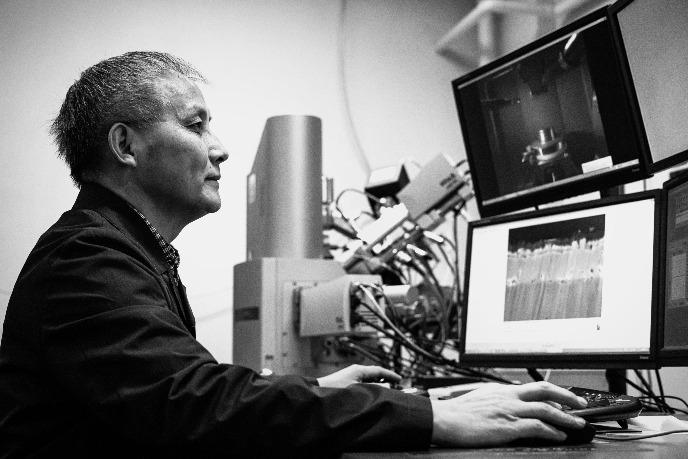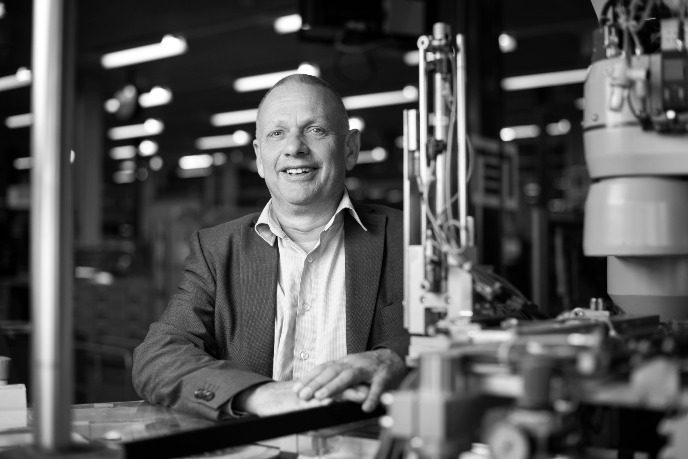Zal het buigen of barsten?

‘De staalindustrie staat aan de vooravond van grote veranderingen,’ vertelt Francesco Maresca, materiaalwetenschapper van de Rijksuniversiteit Groningen. ‘We moeten opnieuw uitvinden hoe we staal produceren, en hoe we het gebruiken.’ Maresca is samen met RUG-materiaalwetenschappers Bart Kooi, Yutao Pei en Jan Post betrokken bij het project Groeien met Groen Staal dat 124 miljoen euro krijgt uit het Nationaal Groeifonds, en nog eens 53 miljoen uit private investeringen. Dit project wordt uitgevoerd door een groot consortium van bedrijven, universiteiten en hogescholen dat samen toewerkt naar een nieuwe, groenere levenscyclus voor staal.
FSE Science Newsroom | Charlotte Vlek
We produceren in Europa bijna een kilo nieuw staal per persoon per dag; al dat staal gaat naar dagelijkse gebruiksvoorwerpen zoals sleutels en paperclips, maar ook (medische) apparatuur, auto’s en gebouwen. Sinds jaar en dag gebeurt de productie van staal door ijzererts en cokes (steenkool) samen te verhitten. Dit onttrekt zuurstof aan de ijzererts, en geeft als restproduct CO2, wat de staalindustrie tot een van de grootste industriële vervuilers wereldwijd maakt.
Dat kan anders: door waterstof (H2) in plaats van steenkool te gebruiken, zou als restproduct water (stoom) ontstaan. Dat is beter voor de natuur, maar ook voor de omwonenden van de hoogovens. Alleen, een ander productieproces heeft ook een effect op de eigenschappen van dit groene staal.
Zelfde samenstelling, ander materiaal
Met dezelfde chemische samenstelling kan een materiaal toch heel verschillende eigenschappen hebben, omdat de atomaire structuur anders is
‘Met dezelfde chemische samenstelling kan een materiaal toch heel verschillende eigenschappen hebben, omdat de atomaire structuur anders is,’ vertelt Bart Kooi. ‘Staal is wat dat betreft een heel ingewikkeld materiaal.’ Maresca vult aan: ‘Vergelijk het met het koken van pasta. Hetzelfde merk pasta kan plakkerig of krokant worden, afhankelijk van hoe je het kookt. Uiteindelijk komt het aan op de microstructuur van het materiaal: hoe de moleculen aan elkaar binden in het kookproces.’
Daarom gaan de wetenschappers van de RUG en de andere partners samenwerken in een krachtige combinatie van experimenteel, fundamenteel en toepassingsgericht onderzoek om uit te zoeken wat de beste manier is om op een milieuvriendelijkere manier staal te ‘koken’. Dit moet uiteindelijk leiden tot modellen die de materiaaleigenschappen van het groenere staal kunnen voorspellen en optimaliseren.
(Tekst gaat verder onder de foto's)




Observeren en modelleren
De productie van het groene staal zal in de laboratoria van Tata Steel Nederland of bij Alleima Zweden plaatsvinden. Daarna gaan de wetenschappers van de RUG ermee aan de slag: Bart Kooi kan onder zijn elektronenmicroscopen de atomaire structuur van het materiaal bekijken. Met deze informatie zal Francesco Maresca computermodellen ontwikkelen van de microstructuur van het materiaal, die weer worden gecheckt met observaties onder de microscoop.
Zal het eerder buigen of barsten onder hoge krachten?
Samen kunnen deze modellen en observaties voorspellen wat voor eigenschappen het materiaal zal hebben: hoe sterk zal het zijn, hoeveel plasticiteit heeft het, zal het eerder buigen of barsten onder hoge krachten?
Ontwikkelen en voorspellen
Ook de behandeling die nodig is om staal roestvast te maken, heeft effect op de materiaaleigenschappen: voor een roestvaste coating moet het geheel worden verhit. Yutao Pei gaat werken aan nieuwe coatings en coatingstechnieken. Hij zal daarbij nauw samenwerken met Bart Kooi en Francesco Maresca, die in de gaten zullen houden of het staal met de nieuwe coating de juiste structuur behoudt.
Jan Post, verbonden aan de RUG en Philips Drachten, is verantwoordelijk voor de gebruikers-fase van het gehele consortium. Hij ontwikkelt samen met andere instellingen en bedrijven modellen voor specifieke toepassingen, op basis van informatie uit de observaties en computermodellen van Kooi en Maresca. Met de modellen van Post is te voorspellen hoe bijvoorbeeld een scheermesje gemaakt van een nieuw type groen staal zich zal houden na veelvuldig gebruik, of een auto. Of hoe lang de lagers van een windturbine meegaan, of het landingsgestel van een vliegtuig.

